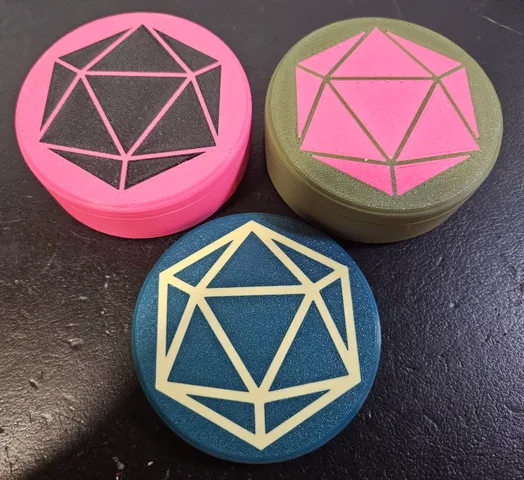
Dice Puck
prusaprinters
This is a magnetic dice puck carrying case for a standard set of gaming dice. It is sized to fit a standard set of dice(22mm D20) and 6mm x 2mm strong magnets. I created it as a “something to do” project based off some designs I'd seen online. There are lots of projects out there like this, but this one is mine.The puck is designed with an icosahedron logo embedded in the lid for multicolor printing (which can be ignored for single-color printing). This is not embossed or debossed, rather it prints multicolor right in the first couple of layers for a very nice overall appearance, especially when printed on a textured plate. There are two versions - one filled in, and one as an outline (see images).SlicingThe included .3mf project file for Bambu Studio is already set up for two colors with a magnet tolerance of 0.15mm, which seems to work well on both a Bambu X1C and a well-calibrated Ender 3. If you can't or do not want to use that file, then you will need to determine your magnet fit (see below), select the correct models, and follow the steps below to set the color for the design on the lid.You can just change the color of the logo on the lid using the paint tool, but that will only go one layer deep. The logo is designed to be at least 2 layers deep into the lid (possibly more, depending on your layer height), and doing it the way I outline below ensures that all the layers will be printed in the chosen color. This will result in a more vibrant logo color and much better overall appearance of the logo on the lid.Bring the model file into your slicer (if asked, keep the model together as parts)Flip the lid over so that the top is on the print plateSplit the model into partsChange Process View from Global to ObjectsAs you click on objects in the list, they will be highlighted on the plate. Control- and/or Shift-Click on all the logo parts in the object list, then right-click on one of them and change the filament to the desired color(s).PrintingThe model works at 0.28mm, but is much nicer, in my opinion, at 0.20mm or lower because the curves are smoother and the lid design seems to print more cleanly. This can be seen in the images - the light green and magenta lids were printed at 0.28mm, while the dark green lid was printed at 0.20mm.You can print the tolerance and alignment tools at 0.28mm. There are small holes on the back of each tool to allow you to recover the magnets by pushing in something thin like a small paperclip or tiny hex wrench.No supports are needed for any of the models.Determining Magnet FitThis design uses 6mm x 2mm strong magnets. I've included a small tolerance test model - print it and test your magnets in the tool to determine the best fit. The tool includes the nominal magnet diameter, +0.1mm, +0.2mm, and +0.3mm. You want something that presses in easily enough but is tight enough to not easily pull the magnet back out. Choose the models named with a "-0.X0" where X is the number on the tool above the best fit.Note that there is also a "-0.15" version, which is the one used in the .3mf project file and which has worked best for me on well-calibrated printers.Feel free to use glue if you like, but with the right fit it shouldn't be needed.Installing the MagnetsI've included a small alignment tool that will ensure you get the magnet polarities right. The ends of the alignment tool are labeled L for lid and B for base.To set up the tool, start with two stuck together magnets. Carefully separate them and, ensuring that you maintain that alignment, slide one into each end of the tool. Test it by picking up a magnet with each end and confirming they are correctly aligned to each other.To install the magnets, use the L end of the tool to pick up a magnet and press it into place in one of the lid magnet holes. Repeat for each magnet hole in the lid. Then do the same for the base using the B end of the tool.
With this file you will be able to print Dice Puck with your 3D printer. Click on the button and save the file on your computer to work, edit or customize your design. You can also find more 3D designs for printers on Dice Puck.
